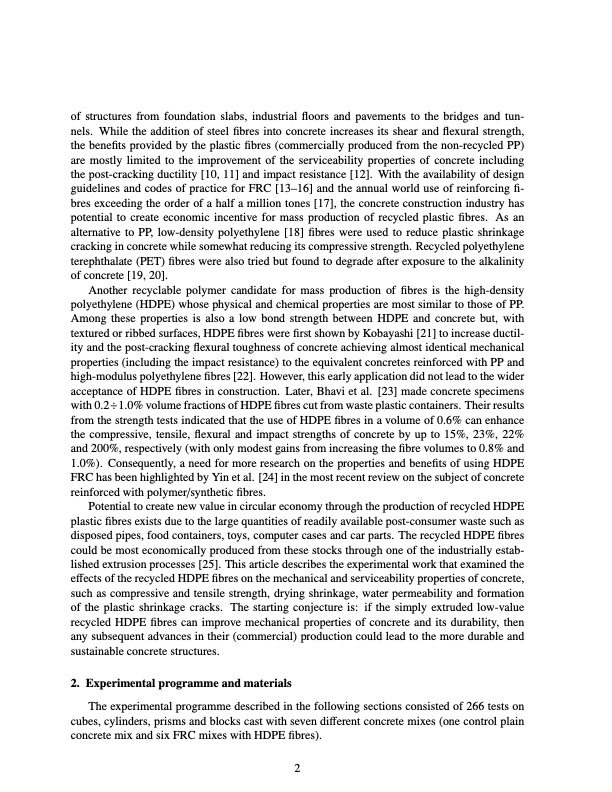
PDF Publication Title:
Text from PDF Page: 003
of structures from foundation slabs, industrial floors and pavements to the bridges and tun- nels. While the addition of steel fibres into concrete increases its shear and flexural strength, the benefits provided by the plastic fibres (commercially produced from the non-recycled PP) are mostly limited to the improvement of the serviceability properties of concrete including the post-cracking ductility [10, 11] and impact resistance [12]. With the availability of design guidelines and codes of practice for FRC [13–16] and the annual world use of reinforcing fi- bres exceeding the order of a half a million tones [17], the concrete construction industry has potential to create economic incentive for mass production of recycled plastic fibres. As an alternative to PP, low-density polyethylene [18] fibres were used to reduce plastic shrinkage cracking in concrete while somewhat reducing its compressive strength. Recycled polyethylene terephthalate (PET) fibres were also tried but found to degrade after exposure to the alkalinity of concrete [19, 20]. Another recyclable polymer candidate for mass production of fibres is the high-density polyethylene (HDPE) whose physical and chemical properties are most similar to those of PP. Among these properties is also a low bond strength between HDPE and concrete but, with textured or ribbed surfaces, HDPE fibres were first shown by Kobayashi [21] to increase ductil- ity and the post-cracking flexural toughness of concrete achieving almost identical mechanical properties (including the impact resistance) to the equivalent concretes reinforced with PP and high-modulus polyethylene fibres [22]. However, this early application did not lead to the wider acceptance of HDPE fibres in construction. Later, Bhavi et al. [23] made concrete specimens with 0.2÷1.0% volume fractions of HDPE fibres cut from waste plastic containers. Their results from the strength tests indicated that the use of HDPE fibres in a volume of 0.6% can enhance the compressive, tensile, flexural and impact strengths of concrete by up to 15%, 23%, 22% and 200%, respectively (with only modest gains from increasing the fibre volumes to 0.8% and 1.0%). Consequently, a need for more research on the properties and benefits of using HDPE FRC has been highlighted by Yin et al. [24] in the most recent review on the subject of concrete reinforced with polymer/synthetic fibres. Potential to create new value in circular economy through the production of recycled HDPE plastic fibres exists due to the large quantities of readily available post-consumer waste such as disposed pipes, food containers, toys, computer cases and car parts. The recycled HDPE fibres could be most economically produced from these stocks through one of the industrially estab- lished extrusion processes [25]. This article describes the experimental work that examined the effects of the recycled HDPE fibres on the mechanical and serviceability properties of concrete, such as compressive and tensile strength, drying shrinkage, water permeability and formation of the plastic shrinkage cracks. The starting conjecture is: if the simply extruded low-value recycled HDPE fibres can improve mechanical properties of concrete and its durability, then any subsequent advances in their (commercial) production could lead to the more durable and sustainable concrete structures. 2. Experimental programme and materials The experimental programme described in the following sections consisted of 266 tests on cubes, cylinders, prisms and blocks cast with seven different concrete mixes (one control plain concrete mix and six FRC mixes with HDPE fibres). 2PDF Image | Mechanical properties of concrete reinforced with recycled HDPE

PDF Search Title:
Mechanical properties of concrete reinforced with recycled HDPEOriginal File Name Searched:
concrete-reinforced-plastics.pdfDIY PDF Search: Google It | Yahoo | Bing
Development of a solar powered Electric Ship The Electricship website originally started off as a project to develop a comprehensive renewable, affordable, modular electric ship... More Info
Modular Boat Hull Composite The case for a unsinkable, modular composite hybrid boat hull... More Info
MS Burgenstock Hybrid Electric Catamaran Lake Lucerne Unique shuttle servicing Lucerne to the Burgenstock Resort... More Info
Ground Power Unit GPU Powered by Lithium Ion Batteries The goal of the Ground Power Unit is to provide a readily accessible, modular, ready-to-power solution for remote power... More Info
| CONTACT TEL: 608-238-6001 Email: greg@electricship.com | RSS | AMP |